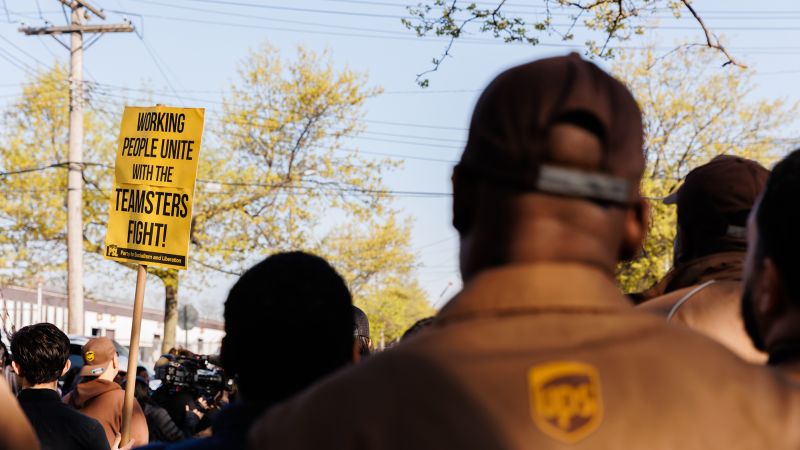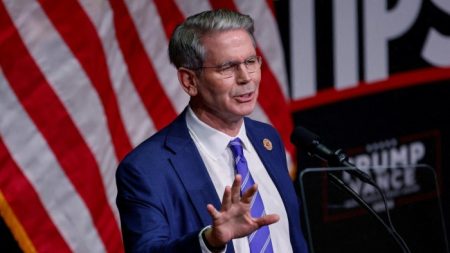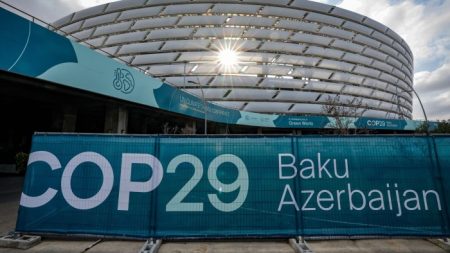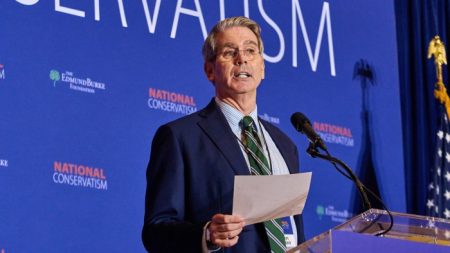Members of the Teamsters union are almost certain to approve a massive strike at UPS in a vote concluding Friday. A prolonged work stoppage could severely damage the economy – but a strike is still more than seven weeks away, if it happens at all.
Strike votes are a common part of labor negotiations, designed to give the union negotiators leverage while trying to reach an agreement. They typically pass overwhelmingly, and the majority of contract negotiations are concluded without a strike.
If a strike does come, it would be the largest against a single employer in America’s history. More than 330,000 Teamsters work at UPS
(UPS), making it the largest unionized employer in the private sector. And it is crucial to the nation’s economy, with an estimated 6% of the United States’ gross domestic product, the broadest measure of economic activity, moving aboard UPS
(UPS) trucks. It delivered 18.7 million domestic packages a day in the first three months of the year.
The current five-year contract expires on July 31, meaning a strike could start on August 1 if there is no agreement on a new deal before then. But there have been signs of progress at the negotiating table.
This week, the Teamsters announced they had reached a tentative agreement on one of the key issues in negotiations, its push to get air conditioning for UPS’s fleet of 95,000 delivery vans, the overwhelming majority of which only have a single fan to combat heat on hot days.
The union has argued that beyond the issue of driver comfort, the lack of air conditioning is a health and safety issue for members. The union said temperatures of more than 120 degrees have been recorded in the cargo compartment of the vans, and that workplace safety regulators have issued citations and hazard letters against the company for work conditions.
At least one heat-related death of a UPS driver in Texas is being investigated by the Occupational Safety and Health Administration.
But the tentative agreement will require air conditioning only on future van purchases, not the retrofitting of existing vans. There will be other retrofitting measures to reduce the heat in the cargo area of the vans, though.
UPS said it is taking steps beyond air conditioning for vans to help drivers deal with the heat, including cooling sleeves and other heat-reducing clothing. It said that safety is a priority for the company.
The union said that it has reached tentative agreements on more than 40 other issues as well, but that there is still a lot of work to be done to reach a deal, particularly on wages.
The Teamsters haven’t publicly disclosed the wage increase they are seeking, but they point to record profits that UPS recorded in recent years. UPS profits have nearly doubled during the five-year life of the current contract, from an adjusted net income of $6.3 billion in 2018 to $11.3 billion on that basis last year. The surge in online purchases that started during the height of the pandemic drove record package delivery volumes for UPS and other delivery services.
But UPS profits, revenue and volumes fell in the first quarter compared to a year earlier as the company warned it is seeing signs of a slowdown in shipments.
One of the major pushes for the union is to close the gap between pay scales for different classes of employees, which allowed UPS to begin regular Saturday deliveries in 2019. According to an analysis by Deutsche Bank, the gap is about $6 an hour for the most senior employees and less than $1 a hour for new hires. Closing the gap would cost about $140 million a year, according to the analysis, which it said is less than 0.2% of UPS’s current cost structure.
“This is an incredibly small amount for what appears to be the main ask by the Teamsters,” said the Deutsche Bank analysis.
While other union negotiations might be trying to catch up with the rising cost of living for its members, the Teamsters’ current contract includes a cost of living adjustment already, which helped increase wages at the company by 6.1%, according to Deutsche Bank.
In an effort to assure both customers and investors, UPS CEO Carol Tome has repeatedly expressed confidence that a deal will be struck without a strike.
“While we expect to hear a great deal of noise during the negotiation, I remain confident that a win-win-win contract is very achievable, and that UPS and the Teamsters will reach [an] agreement by the end of July,” Tome said in April.
But Teamsters General President Sean O’Brien, while acknowledging the progress that has been made, refuses to say whether he thinks a strike is likely or not.
“When you get into the meat and potatoes of wages and benefits, things can get very dicey, very controversial,” he told CNN last week. “Our goal is to get the best deal to avoid a strike. If UPS does not give us what they know we need and want, then they will be striking themselves.”
There is also the issue of rank-and-file anger at UPS that could make ratifying a contract difficult, even if an agreement is reached before the strike deadline.
A majority of members voted against ratifying that deal in 2018, only to see the previous Teamster leadership, led by then-president James P. Hoffa, put it in place anyway because not enough of the membership participated in the ratification vote to trigger a strike. That contract became a major issue in the union’s presidential election last year, as the candidate that Hoffa endorsed to succeed him lost to O’Brien.
The provision that allowed the previous contract to be put in place, despite opposition, has been removed, and a “no” vote on ratification will mean a strike this time. O’Brien said that while he is confident that any deal reached will be ratified by members, he does say there is pent-up anger with the company.
“There is a lot a lot of animosity and anger not just during the last contract but what happened during the pandemic,” O’Brien told CNN.
“They weren’t rewarded as UPS made record profits.”
Read the full article here













